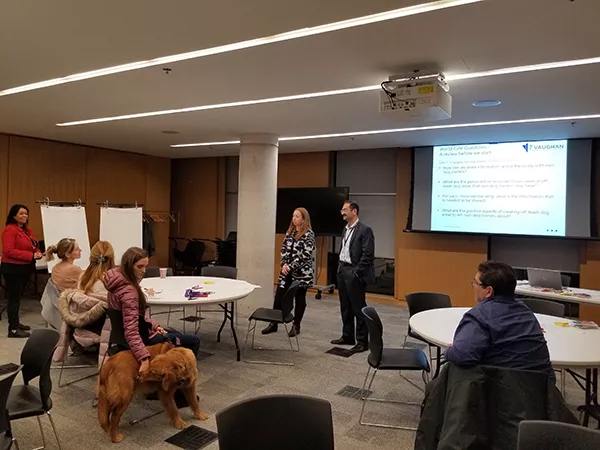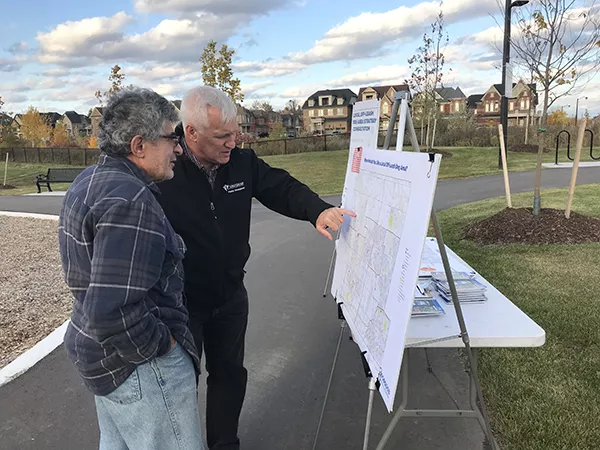About Local Off-Leash Dog Strategy
Background
In 2009, the City of Vaughan constructed and opened the first primary off-leash dog park in Concord/Thornhill Regional Park. Following its opening, residents identified a desire to have a second primary off-leash dog park, so in 2016, the City completed a public consultation process to identify a second location for an off-leash dog area west of Highway 400.
Through the consultation in 2016, the community expressed strong support for smaller, local off-leash dog areas. Based on community feedback, the City continued to explore additional spaces for pets to roam free. A report based on these findings was developed and presented to Council at a Committee of the Whole meeting in December 2016. Learn more about these recommendations in this 2016 Draft Report (PDF).
In 2019, the City engaged the community to provide further input on local off-leash dog areas, desired locations, design, operations and maintenance. At these meetings, strategies to address potential issues were discussed and criteria for future locations were addressed. Citizens were invited to view this video and participate in an online self-directed workshop to learn more about the Local Off-Leash Dog Area Strategy and key findings to date.
Learn more about how the community was engaged
Vaughan residents and stakeholders were extensively engaged throughout the development of the Local Off-Leash Dog Area Strategy. The community was asked questions like, “What does your ideal off-leash dog area look like?” and “What locations and neighbourhoods do you feel could accommodate one?” Opportunities for engagement included:
1. Stakeholder group meetings and pop-up events
The City and consultant team held workshops with dog owners who expressed interest in working with the City to provide input on local off-leash dog areas, including desired locations, design, operations and maintenance. At these meetings, strategies to address potential issues were discussed and criteria for future locations were addressed. In addition to the stakeholder workshops, ten pop-ups were held at various City events to update citizens about the study. Individuals were given the opportunity to take a survey or share their own ideas and goals for future local off-leash dog areas by identifying potential sites on a City map.


2. Online Survey
In December 2019, the City launched an online survey to learn more from Vaughan’s citizens about local off-leash dog areas – participants were asked what their ideal off-leash dog area could look like, and which features, locations and amenities they would like to see in the spaces. More than 900 responses were collected. The survey closed on July 13, 2020. Thank you to those who participated.
3. Online Workshop
Citizens were invited to view this video to learn about the Local Off-leash Dog Area Strategy and participate in an online self-directed workshop to learn more about the Local Off-Leash Dog Area Strategy and key findings to date. Participants were also given an opportunity to provide feedback on eight pilot locations and the Off-Leash Dog Area Stewardship program. The online self-directed workshop ran from July 23 to Aug. 31, 2020. More than 680 respondents participated.
Additional study information
For more information, community members can view a Background Information and Summary Findings (PDF) presentation which includes:
- background research.
- brief history.
- local off–leash dog area etiquette.
- general layout of a local off-leash area.
- site selection process.
- what we heard from the survey and community workshops.
- evaluation matrix and site selection criteria.
- Local Off-Leash Dog Area Stewardship Program.
- reviewed locations.
- the top eight recommended locations.
What are primary and local off-leash dog areas?
Primary off-leash dog areas are larger in size (up to/minimum of 1 hectare in size). Due to their size, they are located in destination parks and are expected to serve a larger number of residents compared to a local off-leash dog area. For this reason, they are likely to be a drive-to facility in addition to walking or biking.
Local off-leash dog areas, are situated in neighbourhoods and are typically smaller in size (up to 0.25 hectares in size). They are expected to serve the residents who live in the neighbourhood and are more easily accessed by foot.
The Standard Levels of Services for both primary and local off-leash areas are provided below.
Primary off-leash dog areas | Local off-leash dog areas |
|
|
Items associated with higher capital and maintenance costs such as water supply, a water fountain, or agility equipment may be considered through sponsorship or donations from an affiliated organization and off-leash dog group or through special funding or grants. However, we do note that with respect to agility equipment, additional review will be required to consider safety and risk of injury.
